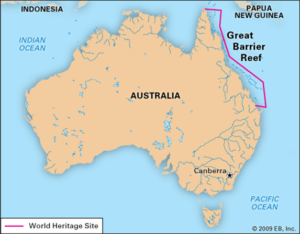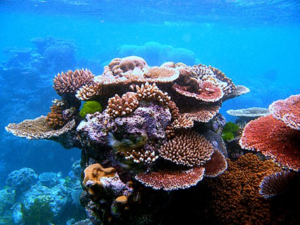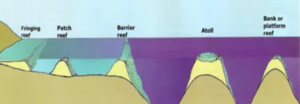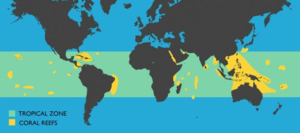| Upsc Relevance-Prelims Pointers:Coral bleaching mechanism,Locations of major coral reefs in India and the world,El Niño-La Niña effects on marine ecosystems. Mains GS Paper II:International environmental governance (UNESCO, Paris Agreement). Mains GS Paper III:Conservation of Environment: Threats to coral ecosystems.Biodiversity & Climate Change: Interlinkages between warming oceans and biodiversity loss.Disaster Management: Role of natural barriers like reefs. |
Why in news?
In 2024, the Great Barrier Reef suffered its worst annual coral loss in four decades, with declines ranging from 14% to 30% across different regions(The Australian Institute of Marine Science’s 2025 survey). This damage was primarily caused by widespread coral bleaching triggered by marine heatwaves, exacerbated by climate change. Despite regrowth in previous years keeping coral cover close to long-term averages, the increased volatility indicates a precarious future for this iconic ecosystem.
Background;About the Great Barrier Reef
The Great Barrier Reef is located off the coast of Queensland, Australia. It spans over 2,300 kilometers and is the largest coral reef system in the world, covering an area of approximately 344,400 square kilometers. The reef is home to an incredible variety of marine life, including over 400 species of coral, 1,500 species of fish, and thousands of other marine organisms. It is also recognized as a UNESCO World Heritage Site due to its unique biodiversity.

The reef plays a crucial role in Australia’s economy, contributing $6.4 billion annually through tourism and supporting over 64,000 jobs. However, the reef is facing significant threats due to climate change, pollution, and other environmental pressures.
Coral Reefs: Overview
Coral reefs are vibrant underwater ecosystems formed by reef-building corals that secrete calcium carbonate exoskeletons. Despite covering less than 0.1% of the ocean floor, they support about 25% of marine species, providing habitat, food, and breeding grounds. These reefs are often referred to as the “rainforests of the sea” due to their high biodiversity.

Coral reefs thrive in tropical waters with minimal nutrients and are typically found at shallow depths, although some can exist in deeper or colder waters.
Coral Reef Types and Locations
Coral reefs are categorized into four types:
- Fringing Reefs: These reefs develop along coastlines and are separated from the shore by shallow lagoons.
- Barrier Reefs: Located farther offshore and separated by deeper lagoons (e.g., the Great Barrier Reef).
- Atolls: Ring-shaped reefs surrounding a lagoon, often formed around sunken volcanic islands.
Patch Reefs: Small, isolated reefs typically found within lagoons.

Location of Coral Reefs:
Coral reefs are found in tropical and subtropical oceans, primarily between the Tropics of Cancer and Capricorn. Some key locations include:

- Coral Triangle (Southeast Asia): The most biodiverse region, covering Indonesia, the Philippines, and others.
- Great Barrier Reef (Australia): The world’s largest reef system, spanning 2,300 km.
- Indian Ocean Reefs: Located in Maldives, Seychelles, and Sri Lanka.
- Pacific Ocean Reefs: Found in Fiji, the Marshall Islands, and French Polynesia.
Coral Reefs in India
India has diverse coral ecosystems, including:
- Gulf of Kutch: Fringing reefs in high salinity and tidal areas.
- Gulf of Mannar: Home to over 3,600 marine species, designated as a Biosphere Reserve.
- Palk Bay: Shallow fringing reefs with high sedimentation.
- Andaman & Nicobar Islands: Contains diverse reefs, supporting species like clownfish and giant clams.
- Lakshadweep Islands: Features coral atolls, vital for local livelihoods.

Conditions for Coral Reef Formation
Coral reefs need specific conditions to grow and thrive:
- Temperature: Ideal range is 23°C to 29°C.
- Depth: Reefs grow best at depths of less than 50 meters, where sunlight can penetrate.
- Salinity: Stable salty water is essential for coral growth.
- Water Clarity: Clear water is necessary for photosynthesis by the symbiotic algae (zooxanthellae).
- Substrate: Hard surfaces like volcanic rocks are required for coral larvae to attach and grow.
Causes of the 2024 Event
- Marine Heatwaves: Prolonged rise in sea surface temperature due to El Niño and anthropogenic climate change.
- Cumulative Stress: Past bleaching events (1998, 2002, 2016, 2017, 2020, 2022) have reduced coral resilience.
- Climate Change Drivers: Fossil fuel emissions and ocean heat absorption contribute to the warming of oceans, which absorb 90% of excess heat.
Implications of Coral Loss
Environmental
- Loss of biodiversity and collapse of reef ecosystems.
- Decline in species that depend on reefs, including fish, molluscs, and turtles, impacting global marine food webs.
- Reduced carbon sequestration potential of reef systems.
Economic
- Threat to Australia’s reef tourism industry, which contributes $6.4 billion annually.
- Loss of livelihoods for communities dependent on fishing and tourism.
- Increased costs for coral restoration projects.
Geopolitical & International
- Risk of UNESCO listing the Great Barrier Reef as ‘In Danger’, impacting Australia’s global environmental reputation.
- Increased diplomatic pressure on Australia to cut carbon emissions faster.
Scientific & Climate Governance
- Raises urgent questions about the effectiveness of climate adaptation measures.
- Highlights the gap between Paris Agreement targets and actual warming trends.
Global and Indian Relevance
- Climate Change & Biodiversity Loss: The crisis reflects similar threats to India’s Gulf of Mannar, Lakshadweep, and Andaman & Nicobar coral reefs.
- SDGs: Affects SDG 13 (Climate Action), SDG 14 (Life Below Water), and SDG 15 (Life on Land).
- Paris Agreement Commitments: Highlights the urgency of meeting the 1.5°C global warming target to avoid more coral bleaching events.
- Disaster Risk Reduction: Coral reefs act as natural barriers, reducing the impact of cyclones and tsunamis.
National and International Steps Taken to Preserve Coral Reefs
National Measures (India)
1 – Wildlife Protection Act, 1972: In 2001, all hard corals were included in Schedule I of the Act, offering them the highest level of legal protection.
2 – Environment Protection Act, 1986 – Grants the Central Government authority to safeguard the marine environment and control marine pollution.
3 – Coastal Regulation Zone (CRZ) Notification, 1991: – Prohibits coral mining and regulates activities along India’s coastline, helping protect coral ecosystems.
4 – Marine Protected Areas (MPAs):
- Five major coral reef MPAs in India:
- Gulf of Mannar Biosphere Reserve (includes the Gulf of Mannar Marine National Park)
- Gulf of Kutch Marine National Park
- Mahatma Gandhi Marine National Park (Andaman Islands)
- Great Nicobar Biosphere Reserve
- Rani Jhansi Marine National Park (Richies Archipelago)
- No-Take Zones (NTZs) within MPAs prohibit all forms of exploitation, limiting human activities to protect coral reefs.
Global Measures
- Aichi Target 10: Aims to reduce pressures on coral reefs and other vulnerable ecosystems affected by climate change and ocean acidification.
- Global Coral Reef Monitoring Network (GCRMN): An operational network of the International Coral Reef Initiative (ICRI), responsible for monitoring and reporting the condition of coral reefs worldwide.
- International Coral Reef Initiative (ICRI): A global partnership aimed at promoting the sustainable management and conservation of coral reefs, encouraging international collaboration to protect these ecosystems through policy changes, research, and funding.
Way Forward for Coral Reef Conservation
Global Actions:
- Accelerate Net Zero commitments and phase down fossil fuels.
- Scale up marine protected areas and biodiversity corridors.
- Increase climate finance for vulnerable ecosystems.
National/Regional Actions (Australia & Others):
- Strengthen reef monitoring and early-warning systems.
- Invest in coral reef restoration, including heat-tolerant coral species.
- Reduce local stressors like overfishing, pollution, and coastal development.
For India:
- Implement Integrated Coastal Zone Management (ICZM) to protect Indian coral reefs.
- Enhance participation in global reef research collaborations like the International Coral Reef Initiative (ICRI).
Conclusion
The Great Barrier Reef’s devastating coral loss is not just an Australian issue but a global wake-up call. Without limiting global warming to 1.5°C, coral reefs worldwide risk irreversible damage, affecting marine life, coastal protection, and human livelihoods. Immediate and concerted efforts are needed to prevent further degradation and secure the future of these vital ecosystems.
UPSC Prelims pyqs
Q. “Biorock technology” is talked about in which one of the following situations?(2022)
a) Restoration of damaged coral reefs
b) Development of building materials using plant residues
c) Identification of areas for exploration/extraction of shale gas
d) Providing salt licks for wild animals in forests/protected areas
Answer: a) Restoration of damaged coral reefs
Q. Consider the following statements:(2018)
- Most of the world’s coral reefs are in tropical waters.
- More than one-third of the world’s coral reefs are located in the territories of Australia, Indonesia, and the Philippines.
- Coral reefs host far more number of animal phyla than those hosted by tropical rainforests.
Which of the statements given above is/are correct?
a) 1 and 2 only
b) 3 only
c) 1 and 3 only
d) 1, 2 and 3
Answer: d) 1, 2 and 3
UPSC Mains Questions
Q. Coral reefs are often referred to as the “rainforests of the sea.” Discuss the ecological importance of coral reefs and the impact of climate change on these vital ecosystems. (150 words, 10 marks)(2023)
SOURCE- THE HINDU
Found this helpful?
Bookmark for revision, Practice the mains question, and
Share with fellow aspirants! THANK YOU
